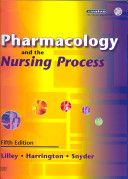Pharmacology And The Nursing Process

Genre
- Textbook
Subject
- Drugs
- Nursing--Study Guides
- Pharmacology
- Textbook
Plot
This market-leading text is known for presenting challenging content in a clear and consistent format that engages students. With an eye-catching design, full-color illustrations, and helpful, practical boxed features that highlight need-to-know information, the new edition of this bestseller continues its tradition of making pharmacology easy to learn and understand. A companion CD includes resources such as 450 NCLEX examination-style review questions, 26 state-of-the-art animations, and 9 IV therapy and 5 medication errors checklists. Study Skills Tips include practical advice on time management, note taking, study techniques, and test taking. Drug profiles highlight the pharmacokinetics and unique variations of individual drugs. Case studies and critical thinking activities test students' knowledge and understanding. Medication Errors: Preventing and Responding chapter discusses specific nursing measures to prevent medication errors, possible consequences of medication errors to nurses, responses to errors, reporting and learning from mistakes, and other ethical issues. Patient teaching tips include key points to convey to patients, their families, and caregivers. Points to Remember boxes summarize major concepts in a bulleted format. NCLEX exam-style review questions provide a pharmacology review and add a new emphasis on prioritization. e-Learning activities boxes list related content and exercises on the companion CD and Evolve website. Key drugs are highlighted with an icon for quick identification. Photo Atlas of Medication Administration depicts steps in drug administration for various routes. Tear-out IV incompatibility chart provides a convenient portable reference. Life Span Considerations boxes highlight important age-related implications for pediatric and elderly patients. A new focus on prioritization identifies key nursing information and helps in preparation for the NCLEX® examination. Preventing Medication Errors boxes reinforce concepts introduced in the medication errors chapter and relate them to specific common errors that occur in clinical practice. Evidence-Based Practice boxes summarize current research relevant to safe and effective drug therapy. Laboratory Values Related to Drug Therapy boxes highlight the therapeutic levels of various drugs. Expanded bioterrorism content now includes chemical agents such as ricin. Increased focus on drug class provides a "big picture" knowledge of how various drugs work in the body. Expanded cultural content covers today's increasingly diverse patient population. Pharmacokinetic Bridge to the Nursing Process sections apply key pharmacokinetics information to nursing practice.


 English
English  Nederlands
Nederlands  Deutsch
Deutsch  Français
Français  Español
Español  Magyar
Magyar  српски
српски  Dansk
Dansk  Italiano
Italiano  Svenska
Svenska  Slovenčina
Slovenčina  Português
Português 
